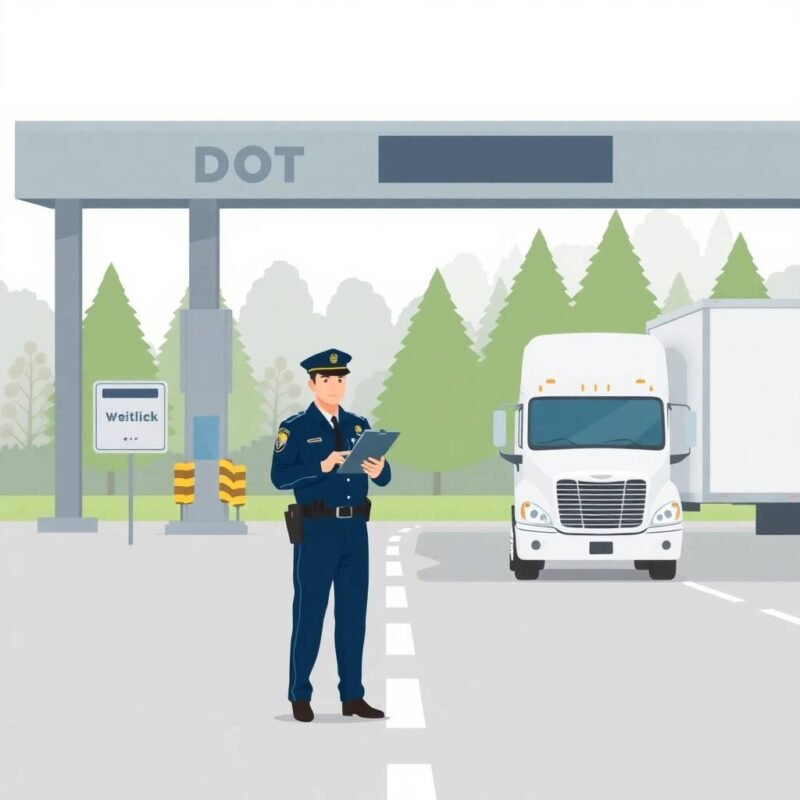1. Understanding the Basics: What Is a DOT Medical Certificate and Who Needs One?
Maintaining compliance in the transportation industry requires keeping up with many FMCSA regulations. One critical element is knowing how to maintain DOT medical certificate compliance, which ensures that commercial drivers meet the physical requirements to safely operate a commercial motor vehicle (CMV).
What Is a DOT Medical Certificate?
A DOT medical certificate, also known as a Medical Examiner’s Certificate (MEC), is an official document issued by an FMCSA-certified medical examiner. It verifies that a driver is medically qualified to operate a CMV. If you transport goods or passengers in vehicles over 10,000 lbs., carry hazardous materials, or operate across state lines, you’re required to carry a current certificate.
Drivers must pass a Department of Transportation physical exam, which includes vision, hearing, blood pressure checks, and a review of medical history. The results determine whether a driver receives a certificate valid for up to 24 months—or for a shorter period if monitoring is required.
Who Needs a DOT Medical Certificate?
If you hold a CDL or operate a vehicle requiring DOT oversight, you’re likely required to maintain a valid medical certificate. Owner-operators and small fleets must understand how to maintain DOT medical certificate compliance as part of their broader FMCSA obligations, including driver qualification file requirements and CDL disqualification rules.
Failing to keep current records can lead to disqualifications, fines, or failing a DOT audit. You can schedule an appointment here if you need help keeping your paperwork and compliance up to date.
How to Maintain DOT Medical Certificate Compliance
Learning how to maintain DOT medical certificate compliance means going beyond the exam itself. You must monitor expiration dates, store certificates properly, and ensure your motor carrier submits them to the state licensing agency. Neglecting these steps could be classified as one of many FMCSA compliance mistakes.
For fleet managers, utilizing tools like the DOT compliance checklist for owner-operators ensures that medical certificates are just one part of a comprehensive strategy. For carriers entering the industry, refer to the new entrant safety audit timeline to understand when medical records are typically reviewed.
Integrating Compliance Into Broader Safety Goals
Medical compliance connects to other safety benchmarks, including the FMCSA Safety Measurement System (SMS). A lapse in certificate validity can negatively affect your SMS score and trigger intervention.
It’s also vital to align with related areas such as drug and alcohol testing compliance and FMCSA Clearinghouse compliance. These programs collectively shape your safety profile and audit outcomes.
Avoiding Penalties Through Proactive Planning
Proactive companies stay ahead of renewal deadlines, follow the FMCSA biennial update requirements, and verify information via the FMCSA PIN request process. Adding DOT compliance training for drivers to your program reinforces the importance of medical certifications.
Finally, don’t forget to monitor your UCR filing deadlines and FMCSA insurance filing requirements, as they often tie into audit reviews where medical certificates are scrutinized.
By understanding how to maintain DOT medical certificate compliance, you protect your business, your drivers, and your bottom line.

2. How to Maintain DOT Medical Certificate Compliance: Know the Renewal Timeline
One of the most commonly overlooked aspects of DOT compliance is understanding the medical certificate renewal timeline. For commercial drivers, failure to renew on time can result in disqualification and costly violations. Knowing how to maintain DOT medical certificate compliance starts with a clear understanding of these deadlines and the surrounding documentation requirements.
Why the Renewal Timeline Matters
DOT medical certificates typically expire every 24 months, but depending on your health conditions, a medical examiner may issue a certificate valid for a shorter period. Missing the expiration date can lead to your commercial driving privileges being suspended. As part of the FMCSA compliance requirements for trucking companies, carriers are responsible for ensuring their drivers’ certifications are always current.
Understanding how to maintain DOT medical certificate compliance includes proactive tracking of each driver’s certificate expiration and scheduling renewal exams well in advance. You can schedule a compliance support session to ensure you stay ahead of renewal deadlines.
Where Medical Certificate Renewal Fits in Compliance
Medical certification is just one piece of the broader compliance picture. It is directly connected to your driver qualification file requirements, which must contain a current and valid DOT medical certificate at all times. Inaccuracies or missing documents during a DOT audit can lead to serious penalties.
Owner-operators can use the DOT compliance checklist for owner-operators to stay organized, while fleet managers should reference the FMCSA compliance mistakes page to avoid common oversights—many of which involve expired or missing medical certificates.
Connected FMCSA Requirements
Understanding how to maintain DOT medical certificate compliance also involves knowing how it relates to other FMCSA programs. For instance, if a driver’s medical condition affects their safety record, it can impact the company’s FMCSA Safety Measurement System (SMS) score. Additionally, drivers who are flagged in the FMCSA Clearinghouse for drug or alcohol violations may also face scrutiny over their medical fitness to operate.
Integrating drug and alcohol testing compliance protocols into your renewal process is essential to maintaining a strong compliance record.
Don’t Forget the Administrative Tasks
Timely submission of the medical certificate to the state driver licensing agency is critical. Failing to do so could result in disqualification, even if the certificate itself is current. This ties into broader requirements like the FMCSA biennial update and FMCSA PIN request process, which ensure that your company’s registration data is accurate and up to date.
For those new to the industry, the new entrant safety audit timeline outlines when compliance with medical certification is reviewed.
Stay Proactive and Avoid Costly Setbacks
Missing a renewal deadline for your DOT medical certificate isn’t just a paperwork issue—it can shut down your operation. Make use of UCR filing deadline resources and the DOT compliance for small fleets guide to stay informed and compliant.
Knowing how to maintain DOT medical certificate compliance is not optional—it’s foundational to operating legally and safely in the trucking industry.

3. Choosing the Right Medical Examiner: Why FMCSA Certification Matters
When it comes to how to maintain DOT medical certificate compliance, one of the most critical—yet often underestimated—factors is choosing the right medical examiner. Not just any physician can perform DOT physicals. The examiner must be certified by the Federal Motor Carrier Safety Administration (FMCSA). Selecting a non-certified provider could result in an invalid certificate, putting your driving privileges—and your business—at risk.
Why FMCSA Certification Is Non-Negotiable
FMCSA-certified medical examiners are trained to understand the specific physical requirements of commercial motor vehicle (CMV) drivers. Their certification ensures consistent, accurate evaluations that align with DOT standards. For carriers, especially those new to the industry, following the new entrant safety audit timeline includes ensuring that all driver medical exams are conducted by FMCSA-approved professionals.
A mistake in examiner selection is among the most common FMCSA compliance mistakes that can lead to disqualification during audits. That’s why understanding how to maintain DOT medical certificate compliance must begin with verifying your examiner’s credentials.
DOT Medical Exams and Broader Compliance
Beyond the exam itself, the medical certificate must be accurately documented within your driver qualification file. The DOT requires that each driver maintain a current, valid certificate, and that it be submitted to the state licensing agency. Failing to do so not only jeopardizes the driver’s license but also risks non-compliance with FMCSA requirements. See the DOT compliance checklist for owner-operators to ensure nothing is missed.
To stay organized, especially when juggling UCR filing deadlines and FMCSA biennial updates, consider scheduling a personalized consultation through this appointment link.
Integrating Compliance Into Safety Protocols
Maintaining medical certification compliance isn’t just about meeting one requirement—it’s deeply connected to overall safety and accountability. Poor recordkeeping or allowing a certificate to expire can impact your FMCSA Safety Measurement System (SMS) score. For companies managing multiple drivers, it’s crucial to implement effective monitoring practices.
Drivers flagged in the FMCSA Clearinghouse or with unresolved drug and alcohol testing compliance issues may also face additional scrutiny, including more frequent physicals. Knowing how to maintain DOT medical certificate compliance helps companies avoid these regulatory traps.
Supporting Documentation and Tools
Carriers can streamline compliance through tools like the FMCSA PIN request process and DOT compliance training for drivers. These tools ensure that everyone involved—drivers, dispatchers, and compliance managers—understands their role in maintaining an active and valid medical certificate.
Even small fleets and owner-operators must prioritize examiner selection and documentation as part of a broader effort to meet all FMCSA compliance requirements.
Don’t Leave Certification to Chance
Your ability to operate legally and safely depends on working with the right professionals. Knowing how to maintain DOT medical certificate compliance means ensuring your examiner is FMCSA-certified, your documentation is current, and your renewal schedule is managed proactively.
Avoid the risk of disqualification—choose a certified examiner and integrate that choice into your full DOT safety compliance checklist.

4. Documentation Duties: Keeping Accurate Records for Every Driver
Accurate recordkeeping is the backbone of FMCSA compliance—and when it comes to how to maintain DOT medical certificate compliance, the stakes are especially high. Every driver’s file must be precise, up to date, and audit-ready to avoid violations that could threaten your authority or trigger costly penalties.
Why Recordkeeping Is Essential to Compliance
Understanding how to maintain DOT medical certificate compliance starts with building and maintaining a compliant Driver Qualification File. This file must include a current and valid DOT medical certificate, among other critical documents. If you’re unsure what must be included, the Driver Qualification File requirements provide a thorough checklist.
DOT regulations require that a driver’s medical certificate be renewed and filed properly to maintain licensure and eligibility. Any lapse in this documentation could result in disqualification and a potential failed DOT audit.
Medical Certificate Tracking and Renewal
A key element in how to maintain DOT medical certificate compliance is knowing when certificates expire and taking action before that date. Many carriers lose track of expiration dates, leading to disqualified drivers and violations during inspections.
To simplify this, use digital systems or hire a compliance support service to manage this process. You can also schedule a one-on-one strategy session through this appointment link to evaluate your tracking processes and get customized solutions.
Integrate Compliance With Broader FMCSA Requirements
Maintaining driver documentation goes beyond the medical certificate. Ensuring compliance across all required areas—including UCR filing deadlines, FMCSA Clearinghouse compliance, and drug and alcohol testing—is essential to avoiding disqualification or audit failures.
In fact, many FMCSA compliance mistakes stem from poor or incomplete documentation practices. Overlooking details in one area can raise red flags across your entire operation, especially during a new entrant safety audit.
Owner-Operators and Small Fleets: Compliance Simplified
For owner-operators and small fleets, documentation duties can feel overwhelming. But learning how to maintain DOT medical certificate compliance is achievable with the right tools and guidance.
A proactive approach includes regular checks against the FMCSA compliance requirements for trucking companies and reviewing the DOT safety compliance checklist to ensure you’re fully covered.
Optimize Safety and SMS Scores
Failing to keep accurate records doesn’t just risk non-compliance—it can damage your FMCSA Safety Measurement System (SMS) score, affecting your reputation and contract eligibility.
Learning how to maintain DOT medical certificate compliance ensures your records support, not sabotage, your standing with regulators and partners.
Conclusion: Build a Culture of Compliance
Accurate recordkeeping isn’t optional—it’s an ongoing duty that supports driver safety, company success, and regulatory integrity. Whether it’s filing a biennial update, tracking CDL disqualification rules, or maintaining driver logs, the principle remains the same: documentation matters.
Make how to maintain DOT medical certificate compliance a priority, and your operations will be stronger, safer, and more successful.

5. How to Maintain DOT Medical Certificate Compliance During Audits and Inspections
Knowing how to maintain DOT medical certificate compliance during audits and inspections is essential for every motor carrier and driver operating under FMCSA authority. Your medical certificate is more than just a document—it’s a direct representation of your fitness for duty and a key component of your Driver Qualification File. During a DOT audit, even a minor oversight in your records can lead to serious penalties or disqualification.
Why Medical Certificate Compliance Is Critical During Audits
When auditors review your records, one of the first things they check is medical certificate documentation. Failing to properly store, update, or verify these certificates is one of the most common FMCSA compliance mistakes. To avoid this, you need to understand how to maintain DOT medical certificate compliance in every aspect of your operation.
Start by ensuring that every driver has a valid certificate on file that aligns with FMCSA medical standards. For complete guidance, consult the Driver Qualification File Requirements to verify that all required documents are organized and up to date.
Integrating Compliance with Broader Audit Preparation
Medical certificates must be aligned with broader FMCSA compliance expectations. For example, if your DOT audit preparation isn’t comprehensive, missing or expired certificates may trigger deeper scrutiny into your operations, including your drug and alcohol testing compliance and your company’s SMS scores.
Learning how to maintain DOT medical certificate compliance also means tying it into your compliance checklist for owner-operators and ensuring your entire team is prepared for inspection at any time.
Scheduling and Renewal Tracking
One of the biggest challenges is staying ahead of medical certificate renewal deadlines. A single expired certificate can ground a driver and count against your safety record. To prevent this, use a digital system or consult with experts. You can schedule your compliance consultation to ensure you’re managing renewals effectively and proactively.
Linking Certificate Compliance with FMCSA Filing Requirements
Your certificate documentation should also be current with FMCSA compliance requirements for trucking companies. This includes having the correct UCR filing deadlines met, maintaining your PIN registration, and aligning with your FMCSA biennial update requirements.
Failing to link your certificate records with other filings can create inconsistencies during audits that raise red flags with investigators.
Training and Fleet-Wide Awareness
To truly master how to maintain DOT medical certificate compliance, ongoing education is vital. Provide your drivers with DOT compliance training to help them understand their roles and responsibilities. Also, reinforce policies across your fleet using resources like the DOT safety compliance checklist.
Conclusion: Preparedness is Protection
Audit success comes down to preparation. Keeping your medical certificate records up to date, accurate, and audit-ready protects your authority and reputation. Whether you’re a small fleet or an owner-operator, staying compliant is manageable if you consistently apply the principles of how to maintain DOT medical certificate compliance across your operation. Take action today, stay ahead of renewals, and work with a compliance expert to stay inspection-ready at all times.

6. The Impact of Medical Disqualifications: What Employers and Drivers Must Know
Understanding how to maintain DOT medical certificate compliance is essential for both drivers and employers in the trucking industry. A medical disqualification doesn’t just sideline a driver—it can disrupt entire operations, trigger audits, and increase exposure to FMCSA penalties. Ensuring every CDL driver remains medically qualified helps protect business continuity and road safety.
The Ripple Effect of Medical Disqualifications
When a driver loses their medical certification, the consequences can be swift and severe. A disqualified driver must immediately cease operating a commercial motor vehicle (CMV), affecting route coverage, customer commitments, and carrier reliability. For employers, this highlights why knowing how to maintain DOT medical certificate compliance is a core component of fleet management.
Employers must act fast when a certificate lapses or is revoked. Keeping up with your driver qualification file requirements ensures you identify disqualifications before they impact operations. If you’re unsure of how to organize these records, the DOT compliance checklist for owner-operators is a helpful starting point.
Prevention Through Proactive Compliance
A strong understanding of how to maintain DOT medical certificate compliance helps prevent medical disqualifications from occurring in the first place. Scheduling regular physicals, keeping renewal reminders, and documenting results properly in your DQ files are essential.
To avoid last-minute disruptions, consider scheduling your DOT medical compliance consultation. This ensures you’re ahead of renewals and aligned with all FMCSA expectations, including biennial update requirements and CDL disqualification rules.
Compliance Beyond Medical Certifications
Medical certificate compliance doesn’t exist in isolation. It connects to every other aspect of FMCSA oversight—from drug and alcohol testing compliance to FMCSA Clearinghouse requirements. One compliance failure can raise red flags across multiple categories.
Knowing how to maintain DOT medical certificate compliance also means staying current with your FMCSA compliance requirements for trucking companies, especially during an FMCSA audit. Overlooking something as basic as a missing medical card can lead to fines or even a downgraded safety rating, reflected in your SMS profile.
Training and Documentation Go Hand-in-Hand
Teaching drivers how to maintain DOT medical certificate compliance through compliance training helps reduce the risk of disqualifications. Reinforce this training with strong documentation procedures that cover everything from driver logs to DVIR compliance.
This proactive approach extends to newer fleets navigating the new entrant safety audit timeline or those managing hazmat compliance, UCR filings, and insurance requirements.
Final Thoughts
Medical disqualifications are more than administrative setbacks—they can jeopardize safety, operations, and FMCSA standing. By mastering how to maintain DOT medical certificate compliance, employers and drivers can prevent these disruptions and build a solid foundation for full DOT compliance. Stay prepared, stay informed, and get the support you need to maintain a safe and compliant fleet.

7. Training and Policy Enforcement: Building a Compliance Culture in Your Fleet
Creating a culture of compliance is the backbone of safe, successful fleet operations. Whether you operate a small team of trucks or a nationwide fleet, knowing how to maintain DOT medical certificate compliance is central to long-term FMCSA compliance. However, compliance doesn’t stop with medical certificates—it requires company-wide policy enforcement, ongoing training, and leadership buy-in.
Why Compliance Training Must Start with Medical Certification
The foundation of a compliant fleet begins with ensuring that every driver knows how to maintain DOT medical certificate compliance. From their first day, drivers should understand the importance of timely medical exams, proper documentation, and updating their records with the FMCSA. Employers can streamline this process by incorporating training into onboarding, using resources such as DOT compliance training for drivers.
Implementing a structured training program also helps drivers recognize how medical certification intersects with broader driver qualification file requirements and impacts overall FMCSA compliance requirements.
Policy Enforcement Starts with Leadership
Leadership plays a pivotal role in teaching teams how to maintain DOT medical certificate compliance. Establishing clear policies around medical exam frequency, renewal deadlines, and documentation helps prevent costly mistakes. Supervisors should routinely reference tools like the DOT compliance checklist for owner-operators and DOT safety compliance checklist to ensure no detail is overlooked.
Employers should also implement internal audits as part of their DOT audit preparation process, making compliance part of the daily routine rather than a reactive process.
Connecting Compliance Across the Board
Medical certificate compliance is directly tied to broader FMCSA mandates, including drug and alcohol testing compliance, Clearinghouse reporting, and CDL disqualification rules. When a driver loses their medical certification, the ripple effect can result in violations across multiple compliance areas.
That’s why building a culture that understands how to maintain DOT medical certificate compliance ultimately strengthens performance in the FMCSA Safety Measurement System and avoids critical FMCSA compliance mistakes.
Use Tech and Tools to Track Compliance
Keeping tabs on certification deadlines is easier when integrated with your FMCSA portal registration, ELD systems, and driver logs. Small fleets can also benefit from targeted guidance on DOT compliance for small fleets and understanding the UCR filing deadlines.
If you need help implementing these systems or clarifying what’s required, you can schedule a one-on-one compliance consultation for expert support.
Final Thoughts
Training and enforcement aren’t optional—they’re essential for companies that want to stay on the road legally and avoid costly downtime. By teaching drivers how to maintain DOT medical certificate compliance and enforcing policies consistently, fleets build a culture of accountability, safety, and FMCSA success.

What is the most important step in learning how to maintain DOT medical certificate compliance?

The most critical step in learning how to maintain DOT medical certificate compliance is ensuring that every driver’s medical certificate is current, valid, and issued by an FMCSA-certified medical examiner. Regular monitoring and proper documentation through a robust Driver Qualification (DQ) file setup and monitoring system is essential to avoid disqualification or audit issues.
How often should drivers renew their DOT medical certificates to stay compliant?

To stay compliant, commercial drivers must typically renew their DOT medical certificate every 24 months. However, certain medical conditions may require more frequent renewals. Understanding how to maintain DOT medical certificate compliance includes knowing your drivers’ renewal dates and implementing calendar alerts or automated monitoring systems. Fleet managers often rely on professional DOT audit preparation support to ensure nothing slips through the cracks.
What happens if a driver’s medical certificate expires while they’re still driving?

If a medical certificate expires, the driver becomes medically disqualified from operating a commercial motor vehicle. This violation can severely impact your CSA score and trigger compliance audits. How to maintain DOT medical certificate compliance means proactively removing expired certificates from your records and leveraging DQ file monitoring tools to track upcoming expirations.
Can medical certificate compliance affect other areas of DOT compliance?

Absolutely. Medical certificate issues can lead to broader DOT compliance challenges, including failing an audit or receiving fines. If you’re unsure where you stand, working with a compliance service that offers UCR filing assistance and centralized file monitoring can help you understand how to maintain DOT medical certificate compliance as part of a larger safety and registration strategy.
Does drug and alcohol testing play a role in how to maintain DOT medical certificate compliance?

Yes, while drug and alcohol testing is separate from the medical certificate itself, both are critical components of overall DOT health compliance. To fully understand how to maintain DOT medical certificate compliance, companies should also integrate drug and alcohol testing management into their compliance strategy. Ensuring these systems are aligned helps prevent disqualifications and supports a safer fleet.
Igor Iturriaga is a transportation compliance expert and founder of Dynamic 305 Miami LLC. He helps owner-operators and fleets stay FMCSA-compliant and audit-ready. https://www.linkedin.com/in/igor-iturriaga-64503217/
